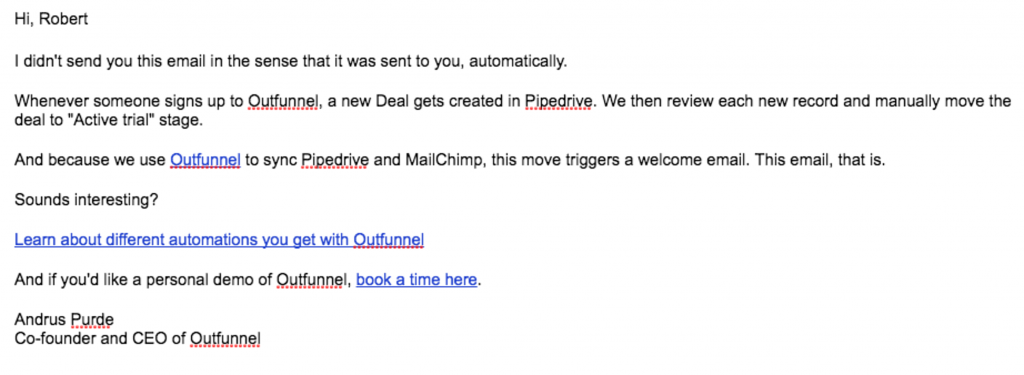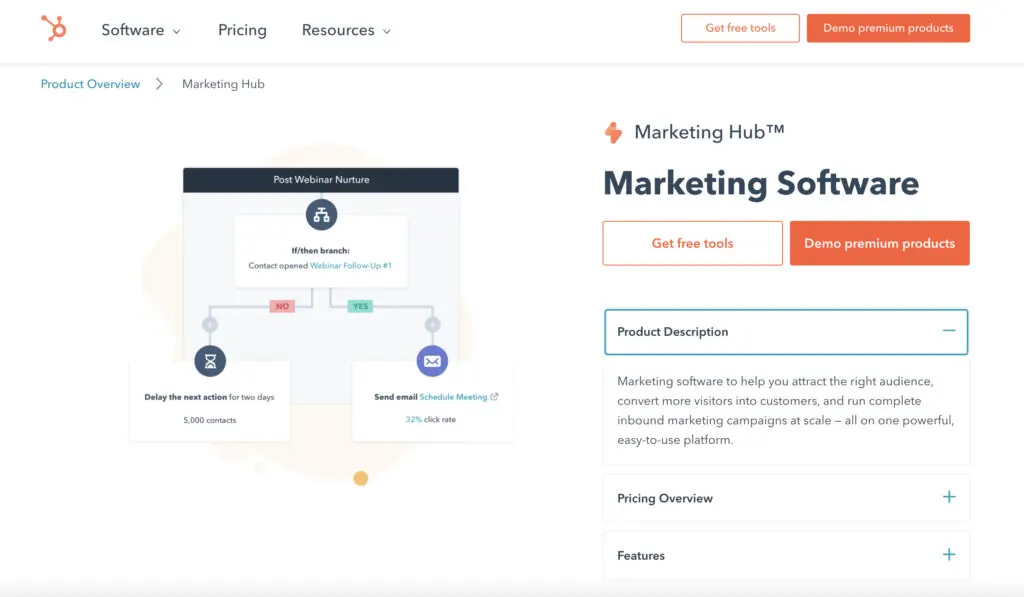Last updated: March 28, 2022
In 1978, Gary Thuerk sent out 397 emails on the ARPAnet, inviting users to a product demonstration of DEC computers. 40 people showed up, and they bought $12,000,000 worth of computers! 40 years later, automated email marketing continues to thrive.
Alas, email marketing in B2B sales no longer looks like your grandfather’s old approach to selling. People are bombarded with marketing messages these days. Forward-thinking companies have noticed that marketing and sales teams are often in conflict, and are increasingly working towards marketing and sales alignment to optimize the funnel and streamline the lead nurturing process.
Automated email marketing is still incredibly lucrative, and the potential is massive, but there are also new challenges that modern businesses have to face.
So, in this article, we will look at:
- Automated email marketing—What, how, and why?
- Building an effective email automation sequence
- Avoiding the most common automated email marketing mistakes
- What does automated email marketing look like in 2022
- Pick the right tools to automate your email marketing
Automated email marketing—What, how, and why?
If you like, you can still technically do email marketing by manually emailing people. But this is extremely tedious and time-consuming.
You could also set up opt-ins to build mailing lists, and then periodically send bulk emails (e.g. newsletters) to them. This is what lots of businesses do these days and call “email marketing”. However, that too can become a considerable time sink and just isn’t so effective anymore.
The key to a good email marketing system is to create automated campaigns with the help of predefined triggers.
Such campaigns are often called drip email campaigns. The predefined triggers send automated email messages in response to your user’s (or lead’s) behavior. For example: maybe the user opted in to listening to your podcast? Maybe they downloaded one of your guides? Whatever action the prospect has taken, an email is automatically sent through an automated email marketing program: “if this” – “send that.”
Once you do this, you no longer need to be paying conscious attention to move the process along – your system can be automatically sending out emails for you, even when you’re asleep or on vacation!

Get the free B2B email marketing crash course
Building an effective email automation sequence
Let’s look at four key processes you need to cover before hitting that Enter key to trigger a sequence.
1. Define your audience – Decide who you want to target
The first step is to narrow down the kind of buyers you are looking to target by analyzing their demographics and interests.
- What are their requirements?
- What are their goals?
- What are their needs?
Answer these questions, and you will establish buyer personas, ultimately making it easier to find more of the same buyers.
You should be looking at what problems your customers are facing, and where the needs gap is. When you figure that out, you can craft the right messages, target consumers, and nurture them further.
Takeaway: Do you have a “buyer persona” document that your team can reference and discuss? If you don’t, set aside an hour or so to answer the broad questions about the worries, anxieties, desires and goals of the people you want to be targeting. You know your buyer persona is good enough when you can clearly determine whether someone is or isn’t a target buyer.
2. Content – Produce content you can include in automated email campaigns
Using the information collected in the first step, aim to have content that matches the needs of your target audience. But, according to Marketing Profs and the CMI, 63% of businesses don’t have a documented content strategy in place. If the goal is to generate leads, you need content to inform your prospects.
Provide a resources section on your website: guides, white papers, infographics sheets, etc. Send an email to your recipient with a link to an article on your website.
Takeaway: The key thing with content, once you’ve developed your buyer persona, is to be clear about what job each piece of content has. You want each piece of content to take your buyer from point A to point B. You’ll have to clearly communicate what those points are.
3. Sequencing – Set up the automated email sequence
When launching an email automation sequence, you need to have a vision of guiding users to take action. You need to work with “the-end-in-mind” to see which messages will move prospects down the sales funnel, and which will be most effective for future campaigns.
Here is an email sequence in action:
- Sign up to receive news on a website
- Email 1: Useful content
- Email 2: Use cases and social proof
- Email 3: Call-to-action (CTA) to sign up for a demo
Congratulations! You’ve just set up an automated email marketing campaign.
Takeaway: The important thing is to be very clear about the precise action that you want your reader to take. It can be tempting to bombard them with all sorts of information – but that actually reduces the likelihood of them moving down the funnel. Identify ONE specific thing you want them to do, and present that clearly.
4. Measure. Rinse. Repeat.
The thing about automated email marketing is that the work is never done. It is a constant process of re-evaluating and redefining the campaigns.
Opt-in style has to be improved, offers need to be personalized, and the messages need to be re-crafted again and again to stay relevant.
You need to continuously test subject lines and email messages to improve results. After all, emails with personalized subject lines have 10-14% higher open rates across industries.
Takeaway: Balance is key here. You don’t want to be spending so much time on re-evaluating and reworking your automated emails to the point where you might as well not have automated emails at all. Be mindful of the amount of time you spend.
Avoiding the most common automated email marketing mistakes
Despite all the potential of email automation, there are certain risks that need to be considered. Keeping these risks in mind and avoiding them can help fine-tune your automated email marketing campaigns. Let’s explore.
1. Automating before you know what works
A mistake we often see is crafting automated emails in bulk based on untested assumptions. Should the second email be a case study to increase the attractiveness of your offering or a quote from a security expert to reduce anxiety?
At Outfunnel we aim to first learn where leads get stuck and try different approaches to address these issues manually. Only after seeing the responses they generate (or rather, don’t generate) do we take the next step and automate.
For example, we used to send all our user onboarding emails manually. While this was time-consuming, it helped us learn and notice patterns of where our users get stuck. Later, we built an automated user onboarding email workflow to address all the potential hurdles, saving 80% of our time.
2. Turning your automated emails on without testing
No matter how well-versed you are with automated email marketing, or how well you have built the strategy, testing is key to ensuring that everything runs smoothly. Testing, testing, and more testing! The golden rule of email marketing.
3. Sending too many emails
If you automate a lot of emails, your exhausting your leads. Start small, and gradually add more automated emails to the series. The time gap in between will help your users adjust to the email frequency and you won’t be put at risk of email overload.
What does automated email marketing look like in 2022
Stay current with email marketing trends when choosing the right platform for your business. Here’s a list of what best-in-class platforms incorporate:
Mobile compatibility
According to Litmus, 46% of email is now opened on a mobile device. You must make your emails mobile-compatible. Design has to be there, and, of course, messaging.
Quality copywriting
The right automated email marketing platform makes it easy to create and send personal-looking email sequences. When the most effective and optimized words are used to target a prospect, with copy that resonates and delights, closing rates increase. Leading companies are investing in content marketing in 2019 more than ever.
Machine learning and artificial intelligence
The best automated email marketing tools often have machine learning or artificial intelligence (AI) components to them.
In B2B email marketing tools, machine learning and AI can be most helpful in testing certain variables and analyzing data—as compared to the more human approach of trial and error. For example, machine learning can be used for subject line testing or the best times to send emails.
Picking the right tools to automate your email marketing
Now that you have a better handle on what an automated email marketing campaign does and looks like, it’s time to take your marketing and sales teams to the next level.
There are various complex and expensive email automation platforms out there—and you can get everything you want if you’re willing to pay thousands of dollars for it.
The challenge for smart, nimble companies is to find find a solution that doesn’t break the bank. This is something we’ve had to do ourselves at Outfunnel—see how we’re automating our email marketing for about $50 a month). Below are our top 5 recommendations for automated email marketing tools.
1. Sendinblue

Sendinblue is a complete marketing automation software for businesses. It is an extremely easy-to-use platform with email marketing, SMS marketing, and lead generation tools to help you drive revenues.
Their full-fledged email marketing tool features a simple drag and drop that is perfect for beginners. You can use their email marketing features to send marketing emails as well as transactional emails, create workflows for automatic follow-ups, and more. Sendinblue can even select the best time to send bulk emails using their AI algorithms to ensure the best email deliverability.
Sendinblue’s pricing is very flexible. You can start off free, with up to 300 emails per day, and their paid plans start at $25/month ($20 per month if you’re willing to commit to an annual subscription).
2. Omnisend

Omnisend is an all-in-one email marketing automation tool built for growth-focused eCommerce brands. Their features cover everything you need to convert web visitors into customers and automate your email marketing to customers. They also offer smart segmentation to create hyper-targeted and relevant email messages.
What really makes Omnisend stand out is that it works with all eCommerce platforms out of the box, including Shopify, Bigcommerce, Magento, WooCommerce and many more.
Omnisend offers a free plan for basic email and SMS marketing, limited to 500 emails per month. Their paid plans start at just $16 per month and adjust based on how many subscribers you have.
3. Mailchimp

Mailchimp is probably the most well-known email automation tool out there. And of course, it does more than just automated emails. Their approach puts your audience at the center of the platform, so you can send marketing emails and automated messages, create targeted ad campaigns, build landing pages, send postcards, facilitate reporting and analytics, and sell online.
As a veteran (and one of the market leaders) of email automation, Mailchimp is definitely very functional and not too difficult to get started with. However, as the platform has grown in complexity over time, adding a CRM functionality among other things, many have turned to Mailchimp alternatives for their marketing automation needs.
Mailchimp’s pricing welcomes getting started for free as well, but the prices ramp up pretty quickly. Their paid plans start at $10/month for up to 500 subscribers and ramp up with every increment of 500 subscribers.
4. ActiveCampaign

And then there’s ActiveCampaign, an email marketing automation platform that has been leaning towards becoming a marketing CRM in recent years. Like most other email marketing automation tools, ActiveCampaign comes with drag-and-drop controls and segmenting options so you can personalize your automated messages.
What sets ActiveCampaign apart from other tools mentioned here is its advanced workflow functionalities. You can track contact engagement with tags, custom fields, analytics, and performance reporting. Pull info from all your offline and digital channels (from social media, live chat, landing pages to text messaging) and automate your marketing accordingly.
ActiveCampaign’s cheapest plan Lite is $15 per month, but you’ll only have 500 contacts. With a list of 5,000 contacts, you’ll be looking at $89 per month.
5. HubSpot Marketing Hub

Now, if none of the four tools above struck your fancy, then perhaps HubSpot Marketing Hub will be right for you. Its email marketing software supports everything from sending super simple personalized email marketing campaigns to automating everything that marketing touches. You can also monitor your email marketing with baked-in analytics, so you can improve your open and click-through rates.
HubSpot Marketing Hub is definitely one of the market leaders, and many people love how it offers an all-in-one marketing automation with CRM as well. As many find HubSpot a little overwhelming to start off with, then we’ll also have you know that there’s a whole world of HubSpot experts and great resources out there to help you get started. If you put in the time, you’ll definitely be able to make the most of your investment.
Speaking of money, HubSpot Marketing Hub is towards the premium end of pricing ranges. The free plan does not give you any email functionality, so you do have to be at least on the $45 per month plan.
Whichever tools you use to set up automated email marketing, be sure to connect your sales and marketing data with Outfunnel. Sign up for a free Outfunnel trial now to see how Outfunnel can help you connect your tools, saving you time and money.



